The global food grade cassia gum powder market is valued at USD 263.9 million in 2025 and is set to reach USD 361.6 million by 2035, recording an absolute increase of USD 97.7 million over the forecast period. This translates into a total growth of 37%, with the market forecast to expand at a compound annual growth rate (CAGR) of 3.2% between 2025 and 2035. The overall market size is expected to grow by approximately 1.4X during the same period, supported by increasing demand for natural food thickeners, growing adoption of plant-based food ingredients, and rising requirements for texture enhancement solutions across food processing, dairy, confectionery, and frozen dessert sectors.
The global food grade cassia gum powder market represents a steadily expanding segment within the hydrocolloid and food ingredients industry, driven by increasing consumer preference for natural food additives and growing demand for texture modification solutions in food processing applications. Food grade cassia gum powder, derived from the endosperm of cassia tora seeds, serves as a natural thickening, gelling, and stabilizing agent widely used in ice cream production, dairy products, meat processing, and various frozen dessert applications. Its classification as a Generally Recognized as Safe (GRAS) ingredient by food regulatory authorities has significantly enhanced its adoption across diverse food manufacturing processes.
The market encompasses various processing grades and particle sizes of cassia gum powder, including refined and unrefined varieties, each tailored for specific food applications requiring different viscosity levels and functional properties. Modern food grade cassia gum powder manufacturing incorporates advanced purification technologies that enhance product quality, remove impurities, and ensure consistent performance characteristics across different food processing environments. The integration of quality control systems, standardized processing methods, and improved packaging solutions has further enhanced the appeal of cassia gum powder among food manufacturers seeking reliable natural alternatives to synthetic thickening agents.
Market dynamics are significantly influenced by stringent food safety regulations, particularly in developed nations where clean label requirements increasingly favor natural ingredients over synthetic additives. The food processing industry's shift toward natural and organic formulations has created substantial demand for plant-based hydrocolloids in dairy products, frozen desserts, processed foods, and specialty applications. Additionally, the growing trend of health-conscious consumption and the associated increase in demand for natural food ingredients has amplified the market opportunities for cassia gum powder across various food categories.
Consumer purchasing patterns show a marked preference for food products containing natural ingredients that provide functional benefits without compromising taste, texture, or nutritional value. The market has witnessed significant technological advancement in processing efficiency, particle size control, and quality standardization, making cassia gum powder more suitable for large-scale food manufacturing operations across diverse applications.
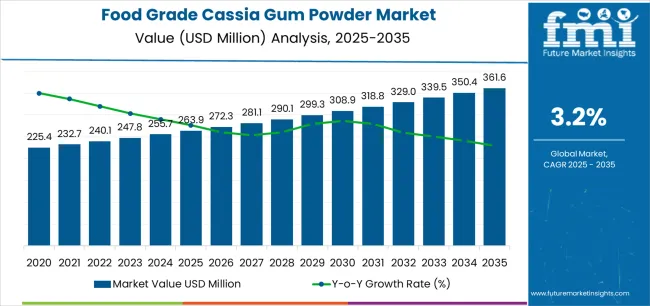
Between 2025 and 2030, the food grade cassia gum powder market is projected to expand from USD 263.9 million to USD 306.4 million, resulting in a value increase of USD 42.5 million, which represents 43.5% of the total forecast growth for the decade. This phase of development will be shaped by increasing adoption of natural food ingredients, rising demand for texture enhancement solutions, and growing availability of standardized processing technologies across food manufacturing applications and industrial processing facilities.
Between 2030 and 2035, the market is forecast to grow from USD 306.4 million to USD 361.6 million, adding another USD 55.2 million, which constitutes 56.5% of the overall ten-year expansion. This period is expected to be characterized by the advancement of specialized processing techniques, the development of premium-grade cassia gum varieties for high-value applications, and the expansion of automated quality control systems across diverse food manufacturing and ingredient processing applications. The growing emphasis on clean label products and natural ingredient preferences will drive demand for advanced cassia gum powder varieties with enhanced functional properties, improved solubility characteristics, and superior performance profiles across different food processing conditions.
Between 2020 and 2024, the food grade cassia gum powder market experienced steady growth, driven by increasing recognition of natural thickening agents and growing demand for plant-based alternatives to synthetic food additives following extensive clean label trends in food manufacturing. The market developed as food processors recognized the functional advantages of cassia gum powder in providing texture enhancement while meeting consumer demands for natural ingredients. Technological advancement in seed processing and powder refinement began emphasizing the critical importance of maintaining product consistency while enhancing functional properties and improving processing efficiency across diverse food manufacturing applications.
| Metric | Value |
|---|---|
| Estimated Value in (2025E) | USD 263.9 million |
| Forecast Value in (2035F) | USD 361.6 million |
| Forecast CAGR (2025 to 2035) | 3.2% |
From 2030 to 2035, the market is forecast to grow from USD 306.4 million to USD 361.6 million, adding another USD 55.2 million, which constitutes 56.5% of the overall ten-year expansion. This period is expected to be characterized by the advancement of biotechnology applications in processing optimization, the integration of automated quality assurance systems for consistent particle size distribution, and the development of specialized grades for premium food applications requiring enhanced functional properties. The growing emphasis on organic certification and traceability will drive demand for premium varieties with enhanced purity levels, improved processing characteristics, and superior quality assurance protocols.
Between 2020 and 2024, the food grade cassia gum powder market experienced consistent growth, driven by increasing awareness of natural food ingredients and growing recognition of plant-based hydrocolloids' effectiveness in supporting texture enhancement across food processing facilities and manufacturing operations. The market developed as users recognized the potential for cassia gum powder to deliver functional advantages while meeting modern requirements for clean label formulations and reliable processing performance. Technological advancement in seed processing techniques and quality control systems began emphasizing the critical importance of maintaining consistency while extending shelf life and improving user satisfaction across diverse food manufacturing applications.
Market expansion is being supported by the increasing global preference for natural food ingredients and the corresponding shift toward high-performance plant-based hydrocolloids that can provide superior thickening characteristics while meeting user requirements for clean label formulations and cost-effective food processing solutions. Modern food manufacturers are increasingly focused on incorporating natural ingredients that can enhance product quality while satisfying demands for consistent performance, precisely controlled texture properties, and optimized processing efficiency. Food grade cassia gum powder's proven ability to deliver functional excellence, texture enhancement capabilities, and diverse application possibilities makes it an essential component for quality-focused food processors and health-conscious product developers.
The growing emphasis on natural ingredient transparency and clean label formulation is driving demand for high-performance cassia gum systems that can support distinctive product characteristics and comprehensive texture management across dairy manufacturing, frozen dessert production, and premium food processing applications. User preference for ingredients that combine functional excellence with natural origin is creating opportunities for innovative implementations in both traditional and emerging food processing applications. The rising influence of health-conscious consumption and advanced processing technologies is also contributing to increased adoption of natural hydrocolloid solutions that can provide authentic functional benefits and reliable processing characteristics.
What is the segmental analysis of the food grade cassia gum powder market?
The market is segmented by type, application, grade, processing method, particle size, and region. By type, the market is divided into refined cassia gum, unrefined cassia gum, and specialty processed cassia gum. Based on application, the market is categorized into ice creams, cheese, frozen daily desserts, meat products, bakery products, and others. By grade, the market includes food grade, pharmaceutical grade, and industrial grade. By processing method, the market encompasses traditional processing, advanced purification, and organic processing. By particle size, the market is divided into fine powder, medium powder, and coarse powder. Regionally, the market is divided into North America, Europe, Asia Pacific, Latin America, Middle East & Africa, and other regions.
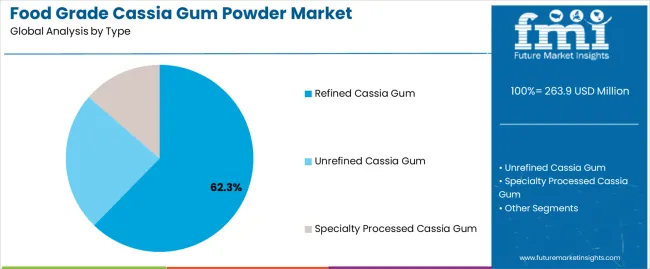
The refined cassia gum segment is projected to account for 62.3% of the food grade cassia gum powder market in 2025, reaffirming its position as the leading type category. Food manufacturers and processing professionals increasingly utilize refined systems for their superior purity characteristics, established quality standards, and essential functionality in diverse food applications across multiple processing categories. Refined cassia gum's proven performance characteristics and established cost-effectiveness directly address user requirements for reliable thickening performance and optimal texture precision in dairy and frozen dessert applications.
This type segment forms the foundation of modern food processing performance patterns, as it represents the technology category with the greatest functional consistency potential and established compatibility across multiple food manufacturing systems. Consumer investments in advanced processing technology and quality optimization continue to strengthen adoption among quality-focused manufacturers. With food processors prioritizing ingredient consistency and processing reliability, refined systems align with both quality objectives and performance requirements, making them the central component of comprehensive food formulation strategies.
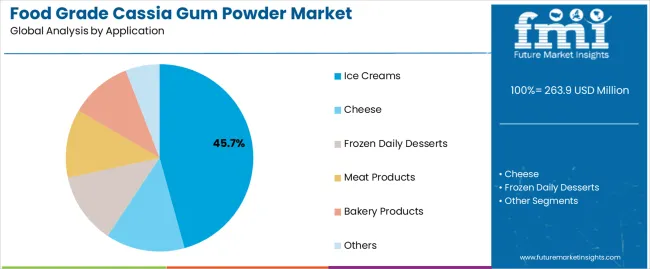
Ice creams is projected to represent 45.7% of the food grade cassia gum powder market in 2025, underscoring its critical role as the primary application for texture-focused manufacturers seeking superior stabilization benefits and enhanced frozen dessert quality credentials. Ice cream producers and frozen dessert manufacturers prefer ice cream applications for their established texture requirements, proven consumer appeal, and ability to maintain exceptional consistency while supporting versatile flavor integration during diverse production processes. Positioned as essential applications for premium ice cream manufacturers, ice cream offerings provide both texture excellence and product stability advantages.
The segment is supported by continuous improvement in frozen dessert technology and the widespread availability of established quality standards that enable texture assurance and premium positioning at the manufacturing level. Additionally, ice cream producers are optimizing ingredient selections to support flavor-specific applications and comprehensive frozen dessert quality strategies. As frozen dessert technology continues to advance and manufacturers seek efficient stabilization methods, ice cream applications will continue to drive market growth while supporting product quality and texture enhancement strategies.
The food grade cassia gum powder market is advancing steadily due to increasing consumer preference for natural food ingredients and growing need for plant-based thickening solutions that emphasize superior functional performance across food processing segments and manufacturing applications. However, the market faces challenges, including competition from alternative hydrocolloid technologies, supply chain considerations, and processing cost factors affecting adoption rates. Innovation in processing optimization and quality enhancement continues to influence market development and expansion patterns.
The growing adoption of food grade cassia gum powder in clean label formulations and natural ingredient systems is enabling manufacturers to develop food products that provide distinctive quality benefits while commanding premium positioning and enhanced consumer acceptance characteristics. Natural ingredient applications provide superior market differentiation while allowing more sophisticated product development features across various food categories. Users are increasingly recognizing the competitive advantages of natural ingredient positioning for comprehensive product quality outcomes and consumer-focused product development.
Modern food grade cassia gum powder manufacturers are incorporating advanced processing techniques, automated quality control capabilities, and standardized particle size systems to enhance functional precision, improve processing effectiveness, and meet manufacturer demands for consistent ingredient performance solutions. These systems improve operational effectiveness while enabling new applications, including specialized food formulations and premium product development protocols. Advanced processing integration also allows manufacturers to support quality assurance positioning and performance consistency beyond traditional ingredient processing operations.
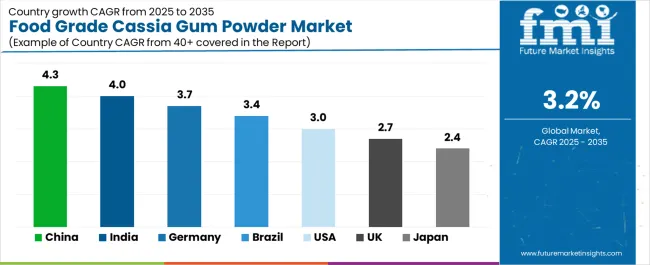
| Country | CAGR (2025-2035) |
|---|---|
| China | 4.3% |
| India | 4% |
| Germany | 3.7% |
| Brazil | 3.4% |
| USA | 3% |
| UK | 2.7% |
| Japan | 2.4% |
The food grade cassia gum powder market is experiencing steady growth globally, with China leading at a 4.3% CAGR through 2035, driven by the expanding food processing industry, growing demand for natural ingredients, and increasing adoption of advanced manufacturing systems. India follows at 4%, supported by established agricultural base, expanding food manufacturing sector, and growing acceptance of value-added processing technologies.
Germany shows growth at 3.7%, emphasizing established food safety standards and comprehensive ingredient quality development. Brazil records 3.4%, focusing on agricultural processing and food manufacturing growth. The USA demonstrates 3% growth, prioritizing advanced food processing technologies and quality optimization.
The report covers an in-depth analysis of 40+ countries, the top-performing countries are highlighted below.
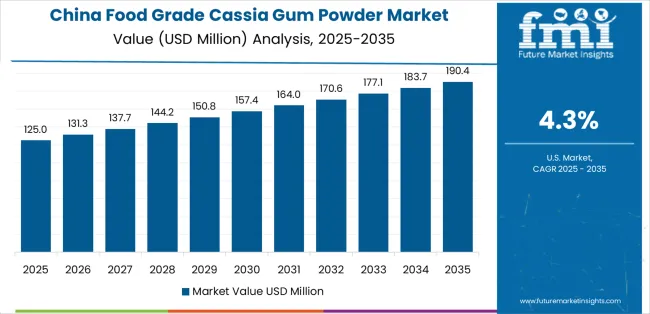
Revenue from food grade cassia gum powder consumption and sales in China is projected to exhibit strong growth with a CAGR of 4.3% through 2035, driven by the country's rapidly expanding food processing sector, favorable government policies toward agricultural value addition, and initiatives promoting natural ingredient technologies across major manufacturing regions. China's position as a leading food manufacturing hub and increasing focus on ingredient quality systems are creating substantial demand for high-quality cassia gum powder in both domestic and export markets. Major food processing companies and ingredient distributors are establishing comprehensive manufacturing capabilities to serve growing demand and emerging quality consciousness opportunities.
Revenue from food grade cassia gum powder products in India is expanding at a CAGR of 4%, supported by strong agricultural foundation, growing food processing investment, and expanding manufacturing capabilities. The country's established cassia cultivation and increasing investment in value-added processing technologies are driving demand for cassia gum powder across both traditional and modern food processing applications. International ingredient companies and domestic processors are establishing comprehensive operational networks to address growing market demand for natural ingredients and efficient processing solutions.
Revenue from food grade cassia gum powder products in Germany is projected to grow at a CAGR of 3.7% through 2035, supported by the country's mature food safety standards, established ingredient regulations, and leadership in food technology. Germany's sophisticated processing standards and strong support for advanced ingredient systems are creating steady demand for both traditional and innovative cassia gum varieties. Leading food ingredient manufacturers and specialty distributors are establishing comprehensive operational strategies to serve both domestic markets and growing export opportunities.
Revenue from food grade cassia gum powder products in Brazil is projected to grow at a CAGR of 3.4% through 2035, driven by the country's emphasis on agricultural processing, food manufacturing growth, and growing ingredient distribution capabilities. Brazilian processors and food manufacturers consistently seek natural ingredients that enhance product quality and support processing excellence for both traditional and modern food applications. The country's position as a Latin American food processing leader continues to drive innovation in specialized ingredient applications and manufacturing quality standards.
Revenue from food grade cassia gum powder products in the USA is projected to grow at a CAGR of 3% through 2035, supported by the country's emphasis on food technology advancement, ingredient quality optimization, and advanced processing integration requiring efficient natural solutions. American manufacturers and quality-conscious processors prioritize performance reliability and ingredient consistency, making specialized cassia gum powder essential components for both traditional and modern food processing applications. The country's comprehensive food technology leadership and advancing quality patterns support continued market expansion.
Revenue from food grade cassia gum powder products in the UK is projected to grow at a CAGR of 2.7% through 2035, supported by established food safety standards, mature consumer markets, and emphasis on ingredient reliability across food processing and manufacturing sectors. British manufacturers and quality-conscious professionals prioritize ingredient performance and processing consistency, creating steady demand for premium natural ingredient solutions. The country's comprehensive market maturity and established quality assurance practices support continued development in specialized applications.
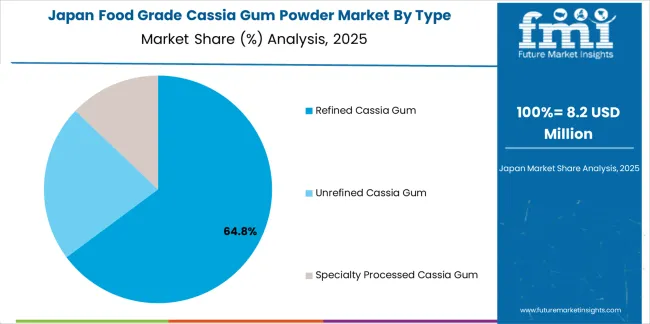
Revenue from food grade cassia gum powder products in Japan is projected to grow at a CAGR of 2.4% through 2035, supported by the country's emphasis on precision manufacturing, food quality excellence, and advanced technology integration requiring efficient ingredient solutions. Japanese manufacturers and quality-focused processors prioritize technical performance and processing precision, making specialized cassia gum powder essential components for both traditional and modern food processing applications. The country's comprehensive quality leadership and advancing processing patterns support continued market expansion.
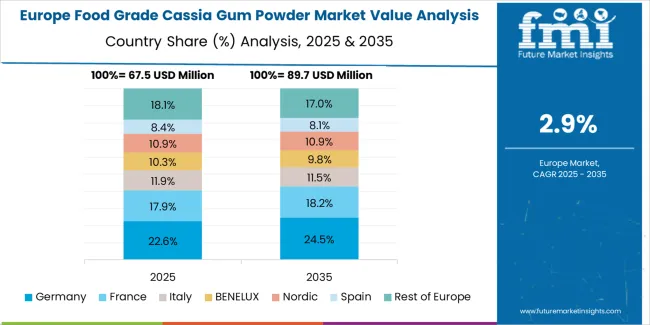
The Europe food grade cassia gum powder market is projected to grow from USD 67.8 million in 2025 to USD 89.5 million by 2035, recording a CAGR of 2.8% over the forecast period. Germany leads the region with a 38.4% share in 2025, moderating slightly to 37.8% by 2035, supported by its strong food processing regulations and demand for premium, high-quality natural ingredients.
The United Kingdom follows with 22.6% in 2025, easing to 22.1% by 2035, driven by a mature food manufacturing market and emphasis on ingredient quality and processing reliability. France accounts for 16.9% in 2025, rising to 17.3% by 2035, reflecting steady adoption of natural food ingredients and quality enhancement. Italy holds 10.7% in 2025, expanding to 11.2% by 2035 as food processing consciousness and specialty ingredient applications grow. Spain contributes 6.4% in 2025, growing to 6.8% by 2035, supported by expanding food manufacturing and ingredient modernization.
The Nordic countries rise from 3.1% in 2025 to 3.2% by 2035 on the back of strong food safety consciousness and advanced quality assurance methodologies. BENELUX remains at 1.9% share across both 2025 and 2035, reflecting mature, quality-focused processing markets.
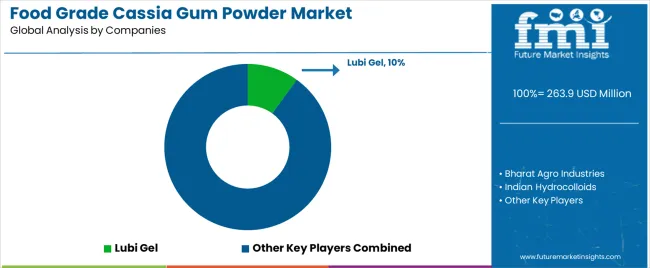
The food grade cassia gum powder market is characterized by competition among established hydrocolloid manufacturers, specialized natural ingredient companies, and integrated agricultural processing providers. Companies are investing in advanced processing technologies, specialized purification systems, product standardization capabilities, and comprehensive distribution networks to deliver consistent, high-quality, and reliable cassia gum powder solutions. Innovation in processing efficiency, particle size optimization, and quality-focused product development is central to strengthening market position and customer satisfaction.
Lubi Gel leads the market with 10% share with a strong focus on hydrocolloid innovation and comprehensive cassia gum powder solutions, offering food processing and manufacturing systems with emphasis on quality excellence and technological heritage. Bharat Agro Industries provides specialized agricultural processing with a focus on Indian market applications and precision manufacturing networks. Indian Hydrocolloids delivers integrated natural ingredient solutions with a focus on processing positioning and quality efficiency.
Agro Gums specializes in comprehensive hydrocolloid systems with an emphasis on food processing applications. Avlast Hydrocolloids focuses on comprehensive ingredient quality with advanced processing and premium positioning capabilities.
The success of food grade cassia gum powder in meeting manufacturer quality demands, food processing requirements, and ingredient integration will not only enhance food quality outcomes but also strengthen global natural ingredient manufacturing capabilities.
It will consolidate emerging regions' positions as hubs for efficient agricultural processing and align advanced economies with comprehensive food ingredient systems. This calls for a concerted effort by all stakeholders - governments, industry bodies, manufacturers, distributors, and investors. Each can be a crucial enabler in preparing the market for its next phase of growth.
| Items | Values |
|---|---|
| Quantitative Units (2025) | USD 263.9 million |
| Type | Refined Cassia Gum, Unrefined Cassia Gum, Specialty Processed Cassia Gum |
| Application | Ice Creams, Cheese, Frozen Daily Desserts, Meat Products, Bakery Products, Others |
| Grade | Food Grade, Pharmaceutical Grade, Industrial Grade |
| Processing Method | Traditional Processing, Advanced Purification, Organic Processing |
| Particle Size | Fine Powder, Medium Powder, Coarse Powder |
| Regions Covered | North America, Europe, Asia Pacific, Latin America, Middle East & Africa, Other Regions |
| Countries Covered | China, India, Germany, Brazil, United States, United Kingdom, Japan, and 40+ countries |
| Key Companies Profiled | Lubi Gel, Bharat Agro Industries, Indian Hydrocolloids, Agro Gums, Avlast Hydrocolloids, and other leading food grade cassia gum powder companies |
| Additional Attributes | Dollar sales by type, application, grade, processing method, particle size, and region; regional demand trends, competitive landscape, technological advancements in agricultural processing engineering, precision quality initiatives, natural ingredient enhancement programs, and premium product development strategies |
The global food grade cassia gum powder market is estimated to be valued at USD 263.9 million in 2025.
The market size for the food grade cassia gum powder market is projected to reach USD 361.6 million by 2035.
The food grade cassia gum powder market is expected to grow at a 3.2% CAGR between 2025 and 2035.
The key product types in food grade cassia gum powder market are refined cassia gum, unrefined cassia gum and specialty processed cassia gum.
In terms of application, ice creams segment to command 45.7% share in the food grade cassia gum powder market in 2025.






Full Research Suite comprises of:
Market outlook & trends analysis
Interviews & case studies
Strategic recommendations
Vendor profiles & capabilities analysis
5-year forecasts
8 regions and 60+ country-level data splits
Market segment data splits
12 months of continuous data updates
DELIVERED AS:
PDF EXCEL ONLINE
Foodservice Equipment Market Analysis - Size, Share, and Forecast Outlook 2025 to 2035
Food Basket Market Forecast and Outlook 2025 to 2035
Food Sorting Machine Market Size and Share Forecast Outlook 2025 to 2035
Foodservice Paper Bag Market Size and Share Forecast Outlook 2025 to 2035
Food Stabilizers Market Size and Share Forecast Outlook 2025 to 2035
Food Packaging Film Market Size and Share Forecast Outlook 2025 to 2035
Food Certification Market Size and Share Forecast Outlook 2025 to 2035
Food Tray Market Size and Share Forecast Outlook 2025 to 2035
Food & Beverage Industrial Disinfection and Cleaning Market Size and Share Forecast Outlook 2025 to 2035
Food Technology Market Size and Share Forecast Outlook 2025 to 2035
Food Tourism Sector Market Size and Share Forecast Outlook 2025 to 2035
Food Processing Boiler Market Size and Share Forecast Outlook 2025 to 2035
Food Packaging Machines Market Size and Share Forecast Outlook 2025 to 2035
Food Minerals Market Size and Share Forecast Outlook 2025 to 2035
Food And Beverage Chemicals Market Size and Share Forecast Outlook 2025 to 2035
Food and Beverage Industry Software Market Size and Share Forecast Outlook 2025 to 2035
Food Packaging Films Market Size and Share Forecast Outlook 2025 to 2035
Food Can Coatings Market Size and Share Forecast Outlook 2025 to 2035
Food Holding and Warming Equipment Market Size and Share Forecast Outlook 2025 to 2035
Food Fortifying Agents Market Size and Share Forecast Outlook 2025 to 2035

Thank you!
You will receive an email from our Business Development Manager. Please be sure to check your SPAM/JUNK folder too.
Chat With
MaRIA